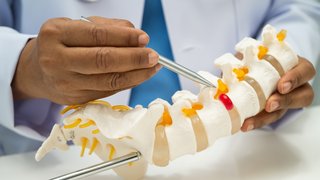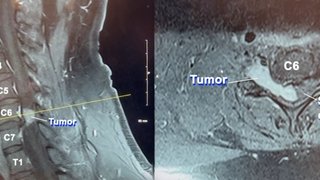‘Tech neck’ epidemic: How to treat the rise in chronic neck pain
January 18, 2023
Quick Links: Diagnosis | Treatments | Prevention | Make an Appointment

Walk through any public space these days and at least half the people you encounter are probably staring at their phones. The familiar pose – head down, eyes fixed on a handheld device – has become the modern-day version of Rodin’s The Thinker (except with clothes).
Americans spend about 5 ½ hours a day on their mobile phones, and a few more hours staring at laptops and computer screens. Combine that with the dramatic shift during the COVID-19 pandemic to working from home, where people often sit for long periods of time in ergonomically unfavorable positions, and the result has become an epidemic of “tech neck,” also referred to as “text neck.”
The excess and repetitive strain on the bones, nerves, and muscles in our necks has given rise to an increase in chronic conditions such as muscle stiffness and joint inflammation, pinched nerves, arthritis, and even bone spurs and herniated discs.
Smartphones, laptops, and other portable digital devices put a sea of information at our fingertips, but they can also be a literal pain in the neck!
At UT Southwestern’s Spine Center, our multidisciplinary team specializes in comprehensive care for patients with all levels of neck pain. Nonsurgical treatments include medication and physical therapy, trigger point and steroid injections, nerve blocks, and minimally invasive techniques such as radiofrequency ablation. If surgery is the best option to relieve your pain and restore function, our expert surgeons offer the most advanced techniques.
Our dependence on smartphones and digital devices doesn’t show any signs of slowing, so now is the time to confront the rising tide of tech neck, which cuts across all age groups, with effective treatments and preventive strategies.

Why is the neck so susceptible to injury?
The typical adult head weighs 10-12 pounds, but when you bend it forward at a 45-degree angle, the amount of force it exerts on your neck increases to nearly 50 pounds.
Humans are upright creatures; we’re not designed to look down for long periods of time. So when we do, it puts extra pressure on the cervical spine area, which consists of seven bones (C1-C7 vertebrae) separated by discs and connected by facet joints. The vertebrae also protect the spinal cord and its many nerves.
Facet joints – two on each vertebra – are instrumental in helping us bend and move our necks freely. But when we strain or injure the facet joints, which act as passageways for nerves, the surrounding muscles in our necks naturally tighten up to try to protect them.
The result can be inflammation, pain, and knots in your neck – aka tech neck.
Of course, tech neck isn’t the only kind of neck injury or pain we see. Bone spurs, degenerative arthritis, and events such as falls, sports injuries, or car accidents can also lead to neck trauma. So can disc herniation and stenosis, or a narrowing of the spinal canal.
Most patients, however, struggle with axial neck pain, which is concentrated in the neck and is usually caused by muscle tightness and joint inflammation.
Related reading: Easy tips to relieve stress-related neck and back pain
Pinpointing neck pain
Diagnosing the source of your neck pain begins with a conversation and a bit of detective work.
We’ll ask you to describe symptoms and answer some questions, such as:
- Do you have headaches or any other pain in your head?
- Does pain radiate down your arm?
- Is there numbness in your fingers?
- Was there an injury that triggered the neck pain?
- What, if anything, have you already tried to relieve the pain?
A physical exam will allow us to test your reflexes and muscle strength, as well as assess the alignment in your cervical spine area. X-rays will show any discrepancies with bone structure and alignment, and an MRI can reveal any soft tissue problems such as a bulging disc or severe arthritis in the joints.
The combination of advanced imaging, a thorough physical exam, and a detailed history of the condition usually allows us to pinpoint the source of your neck pain.
Related reading: Working at home can be a pain in the neck and back
How we treat cervical spine injuries
By the time most patients seek treatment from a specialist, they have already tried several things on their own to relieve their neck pain, ranging from stretches and exercises they found online to over-the-counter medications. Others have gone to a chiropractor, acupuncturist, or deep-tissue masseuse with limited results. And some have already tried physical therapy.
Depending on the condition and the patient, we might recommend guided physical therapy and medication first. But there are also multiple other nonsurgical interventions and procedures that can be very effective:
- Epidural steroid injection: A very potent anti-inflammatory, steroids such as cortisone can be injected directly where a nerve is irritated to provide relief that can last months or years.
- Trigger point injection: If you have a really tight muscle, or knot, injecting medication (usually a local anesthetic and steroid) in the area can calm it down considerably.
- Nerve-root blocks: Injecting anti-inflammatory medication near irritated nerve roots can deliver significant pain relief by shutting off that specific nerve’s pain signal to your brain.
- Radiofrequency ablations: A minimally invasive procedure, also called a rhizotomy, radiofrequency ablation uses a small needle to transmit an electric current to heat up, or cauterize, nerve fibers that are sending pain signals to the joints in the neck. Done with the guidance of an X-ray device called a fluoroscope, we can target the exact nerve branch using live images. We also do several temporary nerve blocks to confirm the correct ablation site.
Injections offer temporary pain relief, usually lasting at least several months and sometimes more than a year – enough time to strengthen the muscles in the neck. With ablation, studies have shown the nerve branches in the neck can regrow in six to nine months, and if they follow the same path a second ablation might be necessary.
While most chronic neck pain doesn’t require surgery, if you are suffering from bone spurs or fractures, herniated discs, or spinal cord compression, surgery could be the best option. The surgeons in our multidisciplinary Spine Center are experts in the most advanced and minimally invasive techniques, but at UT Southwestern we typically recommend conservative treatments before suggesting surgery.
Strategies to prevent or limit tech injuries
Like it or not, portable electronic devices have become an integral part of our lives. So, suggesting to patients that they spend less time on their phones and laptops to protect their necks isn’t really a feasible solution.
In fact, embracing technology could be the more realistic strategy. Try these:

We've got your back (and neck)
At UT Southwestern's multidisciplinary Spine Center, patients will get expert care from a team of physical medicine and rehabilitation doctors and therapists, neurosurgeons, pain management experts, and specialists trained in treating neck and back pain.
- Head’s up phone apps signal a user when they’re tilting their head and neck forward to view the phone. A red head icon means straighten up; green is a go for good posture.
- Posture protector apps use phone technology, such as the gyroscope, to remind you not to slouch by darkening the screen when you do. Other settings can make the phone vibrate or ring instead of going dark.
- Phone and device timers are effective tools to remind you to take hourly tech breaks from working on your laptop, particularly if you’re working from home. Get up from your chair, stretch, and move to help get your neck muscles firing.
- Voice to text is another way you can reduce the amount of time you spend looking down and texting.
Simply remembering to hold your phone at eye level while texting and scrolling will go a long way toward protecting your neck. So will positioning your computer monitor or laptop at a natural horizontal eye level. Other suggestions include using a standing desk if you’re working from home. You can get an adjustable one that sits on a table or countertop for less than $50. Make sure you have adequate lighting so you don’t have to lean forward to see your screen. And find a chair that fits; no more slouching on the couch.
The Thinkers among us may wonder: Will the tech neck epidemic ever subside? But consider that technology often moves at the speed of light, and the market for augmented reality (AR) and virtual reality (VR) headsets is expected to grow tenfold in the next five years. Could it ultimately replace the smartphone? Now, there’s something to think about.
When it comes to today’s chronic neck problems, the bottom line is this: You don’t have to live with the pain. Request an appointment with one of our specialists, including physiatrists, anesthesiologists, and neurosurgeons, at UT Southwestern’s Spine Center or call 214-645-2225.
We have the expertise – and technology – to take care of your tech neck.











